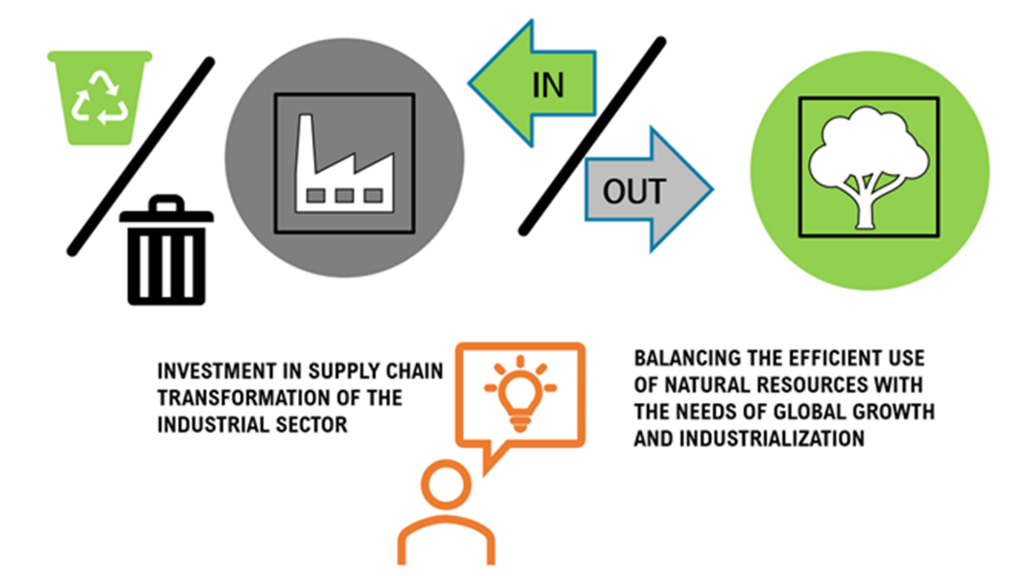ESG engagement is a prerequisite to investing in efficient and critical metals supply chains. Laurent Krull, Director at Ethore SA, describes some fundamentals of responsible investment.
We are in the age of Anthropocene, and human activities must be re-balanced to avoid irreversible and disastrous impacts. Our natural resources must be preserved and be used efficiently according to our needs without compromising the needs of the future generation. The long-term strength and sustainability of the global economy depend on a healthy environment.
Efficiency in metals must be understood in terms of their life cycle and their role in energy efficiency. Energy efficiency can also result from the use of special materials for metals alloys which reduce the amount of iron content or other large CO2 emitters.
Critical metals are essential to achieve decarbonisation goals. Critical metals are these elements of economic importance for key industrial sectors, having a high supply risk (dependence, concentration) and suffering from a lack of substitute materials. Among these, we can mention lithium, cobalt, nickel, gallium, indium, carbon (graphite), vanadium, titanium, light and heavy rare earth elements, niobium, molybdenum, magnesium, tungsten, manganese, zirconium, antimony, rhenium, scandium, bauxite, PGM, barite.
There are increasing concerns about the future availability of mined and non-renewable minerals and materials for our society. Critical metals are essential to transitioning to 100% sustainable energy.
Critical metals requires adapted and sustainable solutions
Our material world is changing, and society evolves with innovations and sustainable concerns. Innovations require speciality metals. More and more critical metals are needed to fuel our modern world facing energy transition.
Today’s economies are dramatically changing, triggered by development in emerging markets, the accelerated rise of new technologies, digitisation, increasing automation, new business models and sustainability policies that continue to revolutionise many industries.
For ten years, Europe has published a list of critical materials every three years (2011, 2014, 2017, 2020)1. In 2020 the new list reported 30 critical raw materials, an increase of more than 114% compared to the first list. Bauxite, lithium, titanium, and strontium have been added to the most recent list. Regarding nickel, the commission indicated; “that it will also closely monitor nickel, in view of developments linked to the growth in demand for raw materials for batteries.”
Nickel and zinc have recently been added to the US critical minerals list.
In addition to the fundamentals of reliance on supply chains for critical raw materials, the COVID-19 crisis has revealed how quickly and to what extent global supply chains can be disrupted. The need to diversify its suppliers and manage the associated risks becomes predominant.
SDG, Scope 3 and SFDR article 8, 9, among the ingredients of transparency
Sustainable finance is on the move, and the duty of disclosure makes it increasingly possible to analyse and differentiate market players. At the asset manager level, their guidelines will need to integrate with the new set of EU rules on sustainable finance disclosure (SFDR), which came into force this year. It requires disclosure of the different levels of sustainability integration and the orientation of each investment strategy. On the other hand, the EFRAG2 project currently being developed aims to establish a standardised and effective financial reporting, making it possible to establish quantifiable and comparable measures (KPIs) between companies.
Transparency for all stakeholders
Consumers are also aware and informed of the growing role of metals in their daily lives. The popularisation of the theme of rare or critical metals is growing, leading to the need to inform consumers and find sustainable solutions. No product will be sold in the future without a label mentioning its impacts. Short circuits, reuse, recycling, and substitutions generate as many solutions as investment opportunities.
ESG commitment found in sustainable solutions and transparency
The ESG approach to the value chain is essential. The modern world will not deviate from the technological needs useful for the energy transition, electric mobility, or the development of efficient and energy-saving materials.
The transparency of supply chains and the validation or permanent control of sources and processing circuits will be developed on a larger scale and will affect the entire mining sector (mineral resource efficiency, upstream supply chain).
Materials science has evolved, and multidisciplinary research now makes it possible to reduce the levels of critical metals useful to overcome any shortage of these components. On the other hand, metals’ life cycle and retention rate at national scales today appear increasingly important (and strategic) to consider effective and economical recycling
(close loop, circular supply chain business opportunities).
eMetals®, therefore, focuses on companies that fall within this responsibility scheme to develop projects whose contribution remains adapted to technological evolution and the life cycle prospects of metals while complying with reducing their impacts according to the United Nations Sustainable Development Goals (UN SDG).
Supply chains sustainability
Supply chains3 are the backbone of global trade and the link between consumers and natural resources.
A responsible and influential investment capacity makes it possible to act for positive impacts at the heart of these chains, whose values need to be shared between the stakeholders.
Supply chains are value chains as much as a chain of responsibility. The urgent need for companies to report on Scope 3 Emission (GHG protocol reporting) only reinforces this aspect of the chain of responsibilities.
Supply chains interact with communities and civil societies. A society for all aims to eradicate poverty, inequalities and give access to education. It will lead to greater participation in economic markets and greater investment growth opportunities. Transparent supply chains reduce reputational risk and enhance the company’s standing as a trustworthy enterprise. It also attracts and retains employees.
Supply chains generate a wide range of environmental impacts interacting with soils, biodiversity, water, and air. All environmental aspects must be addressed carefully as they concern end consumers.
Supply chains are not considered as an investment case. Still, their actors significantly impact GHG emissions (Scope 3 Emissions), their transparency issues affect some critical ESG disclosures, as raw material sourcing or human rights respects. Some OEMs have started to consider vertical integration motivated by ESG materiality and/or technological innovations from companies adopting a coherent sustainable approach. The trend is promised to reinforce in the future offering investment opportunities.
The three dimensions: Risk, Return, Impact
Through our engagement, we will positively impact critical metals supply chains while seeking to help accelerate the transition to a low-carbon, resource-efficient economy.
The performance of a portfolio results from its preferred positioning in a theme with sustainable objectives, the quality of the process for selecting and monitoring securities, the structure and resilience of the portfolio through an approach adopting the principle of double materiality.
Becoming aware of our spheres of impact
The notion of responsibility is linked to a necessity to develop consistency in guidelines to obtain a reliable, sustainable investment strategy. The notions of long-term and impact management make us perceive our sphere of impact and connect us to our environment at large. It is a stinging reminder of the effects of our actions.
The year 2021 was the continuation of the 2020 pandemic with its mutations, its sad waves of hospitalisations and deaths. It was also one year of extraordinary meteorological events resulting from extreme temperature variations around the globe. Nature seems to call us to order. This specific context has contributed to the reflection on the need for change in our reflexes as citizens, collaborators, consumers, and human beings living on Earth.
Today we are living in a changing world of sustainable finance. The certainties of the past are fading in favour of an inclusive society and shared values for a circular economy.
Our responsible approach at ETHORE SA aims to direct capital flows towards sustainable solutions that impact the supply chains of critical materials useful for energy efficiency over the long term. In this regard, we will also positively impact against short-termism affecting markets, industries, and government policies, while unlocking new dynamics and synergies related to transparent and value-added supply chains.
References
1 Critical Raw Materials Resilience: Charting a Path towards greater Security and Sustainability; 2020
2 EFRAG – European Financial Reporting Advisory Group
3 Technology scale and supply chains in a secure, affordable and low carbon energy transition. Applied Energy, Volume 123, 15 June 2014, Pages 296-306
Please note, this article will also appear in the ninth edition of our quarterly publication.










